The "Fukui Prefectural Dinosaur Museum" is located in Katsuyama City, Fukui Prefecture.
Many dinosaur fossils have been found in the Kitadani Formation of the Tetori Group (Early Cretaceous, about 120 million years ago) that spans Katsuyama City, including Fukuiraptor (theropod), Fukuisaurus (ornithopod), Koshisaurus (ornithopod), Fukuititan (sauropodomorph), and Tyrannomimus (theropod).
The Fukui Prefectural Dinosaur Museum opened in July 2000 and has expanded by forming sister relationships with famous dinosaur research institutes and museums such as the Royal Tyrrell Museum of Palaeontology (Alberta, Canada) and the Zigong Dinosaur Museum (Sichuan, China). A new wing was also opened in 2023.
I went on a 3-day trip (5 days including travel) to the Fukui Prefectural Dinosaur Museum.
Preparation & Reservations
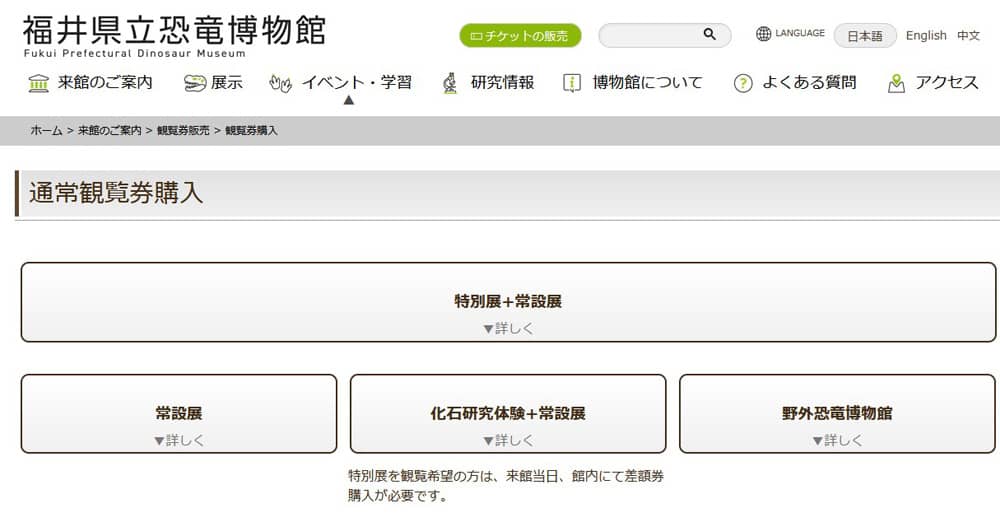
The Fukui Prefectural Dinosaur Museum recommends booking tickets in advance. The official website states, "A timed-entry ticket is required for admission." Same-day tickets may be available depending on the reservation status, but they may not be sold if advance tickets sell out. It seems advisable to book in advance, especially during Golden Week, summer vacation, weekends, and holidays.
Reservations can be made from the "Ticket Sales Page" on the Fukui Prefectural Dinosaur Museum website ( https://www.dinosaur.pref.fukui.jp/en/guide/ticket.html ). Reservations can be made up to 60 days before the desired visit date.
You can book and purchase tickets for the permanent exhibition, Fossil Research Experience + permanent exhibition, Outdoor Dinosaur Museum, special exhibition + permanent exhibition, etc. I made reservations for the following three-day schedule. I had received a "Permanent Exhibition Ticket Exchange Voucher" as a hometown tax return gift, so I only made reservations for some activities and did not purchase all tickets before leaving.
| Day 1 | Fossil Research Experience (1200 yen) + Permanent Exhibition (Voucher) |
| Day 2 |
Permanent Exhibition (Voucher)
Outdoor Dinosaur Museum (1300 yen) |
| Day 3 |
Special Exhibition + Permanent Exhibition (1800 yen)
Fossil Excavation Experience (1150 yen) (Doki Doki Dinosaur Excavation Land) |
(*) Reservations for the "Fossil Excavation Experience" must be made through the Katsuyama Dinosaur Forest website (
https://kyoryunomori.net/dig_experience/
).
(*) Prices are as of September 2024.
Day 1: Permanent Exhibition
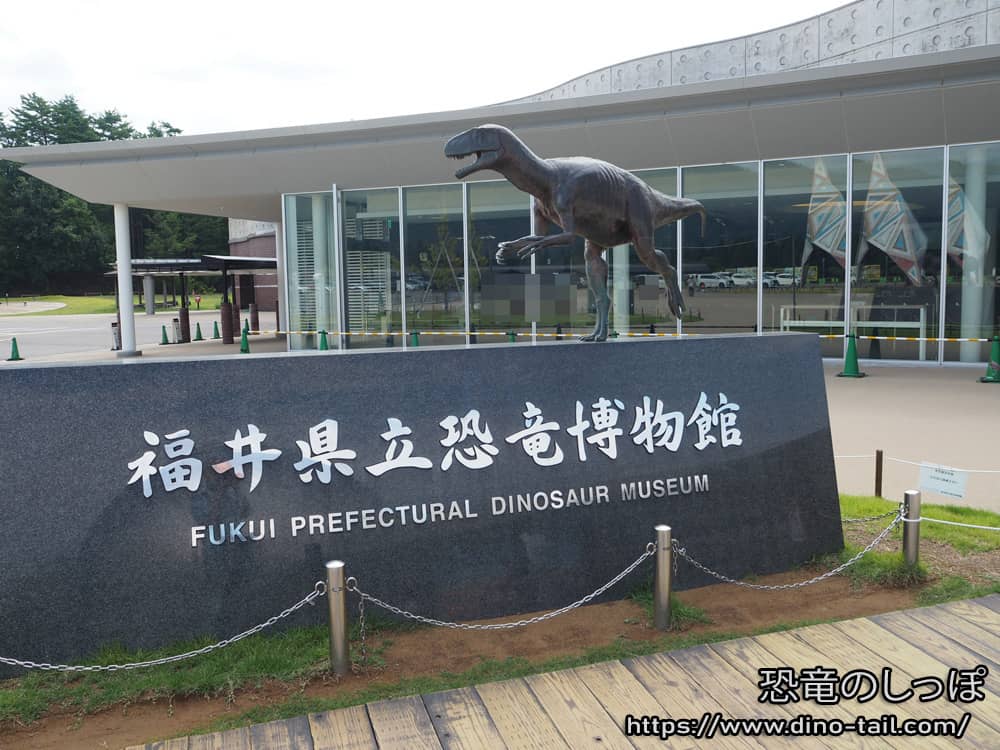
Upon arriving at the museum, I first went to the general reception desk. There, I showed the "Permanent Exhibition Exchange Voucher" from the hometown tax return and the QR code for the pre-booked "Fossil Research Experience" to get my tickets.
After passing through the entrance gate on the 3rd floor, I took a 33-meter escalator down to the basement 1st floor. At the bottom is a passage called "Dino Street," with fossils displayed on both sides like paintings. All the fossils displayed here are real, including Mesolimulus (horseshoe crab), the forelimb of an Anhanguera (pterosaur), and a giant ichthyosaur.
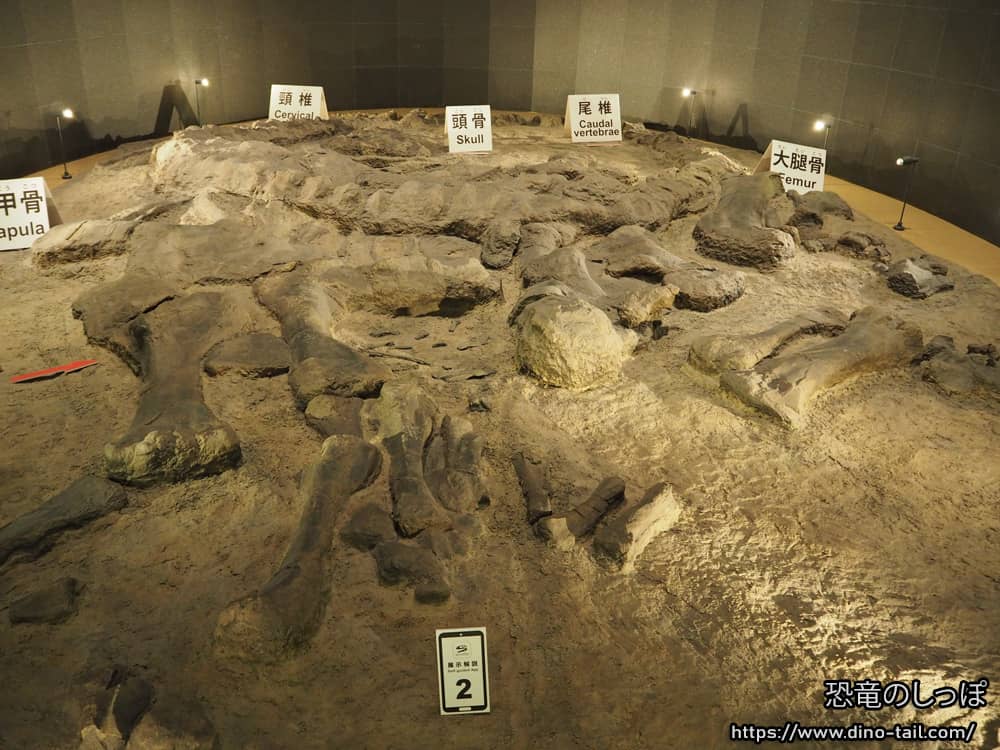
After Dino Street, a 15-meter-long Camarasaurus quarry map fossil greeted me. This specimen was discovered in Wyoming, USA. It is a precious specimen with almost the entire body, from head to tail, preserved. The spine and tail are arched upwards. The head is separated from the neck and lies a short distance away, but the other parts are connected, suggesting it was buried in sediment soon after death.
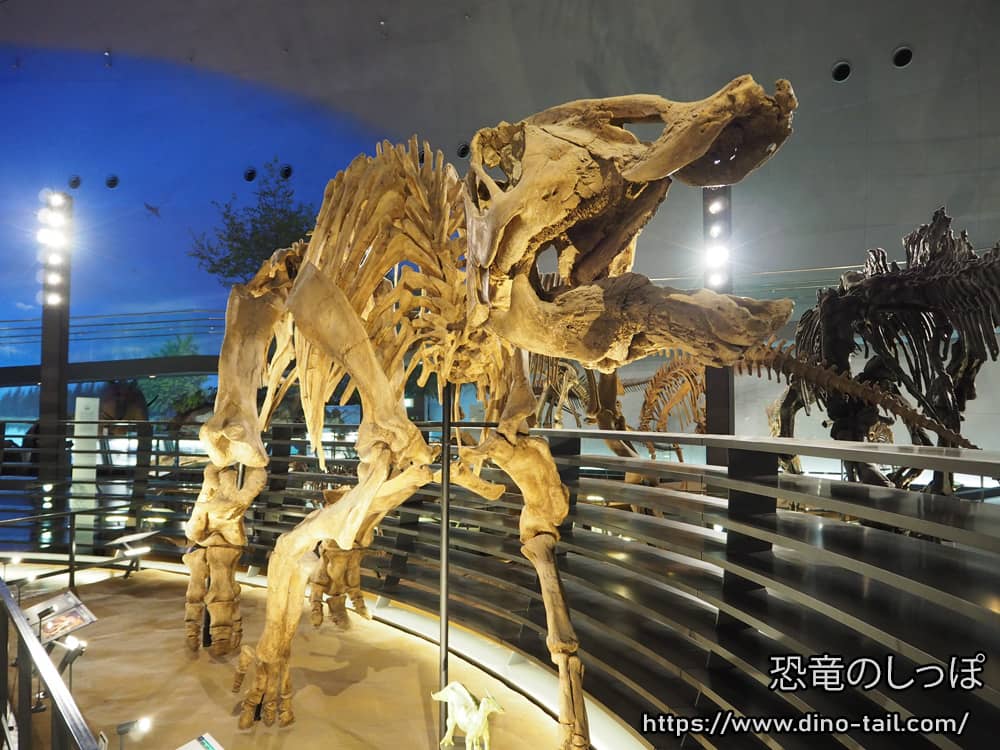
Going up the stairs next to the Camarasaurus quarry map, a moving model of a Tyrannosaurus (three-quarters of the actual size) roars in front. To the right, a complete skeleton of a Saurolophus (10.6m) and to the left, a complete skeleton of a Tarbosaurus (9.4m) were waiting. The 1st floor is the main floor, displaying 50 complete dinosaur skeletons.
The permanent exhibition on the basement 1st floor was divided into "Saurischia" and "Ornithischia" sections.
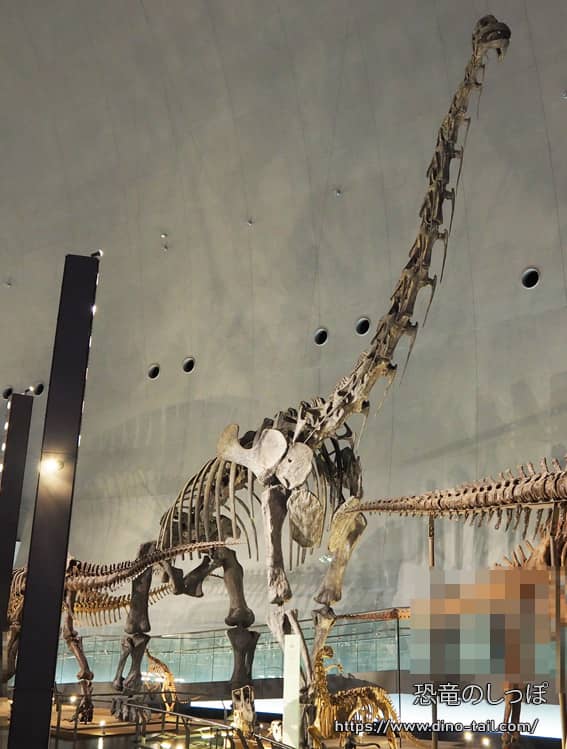
Even for me, who has been to many dinosaur exhibitions and museums, I was excited to see dinosaurs for the first time.
From the Saurischia Sauropodomorpha, there was a complete skeleton of "Brachiosaurus." I had seen skulls on display at dinosaur exhibitions before, but this was the first time I saw the impressive full skeleton. Looking up from under its belly is a unique viewing experience at the Fukui Prefectural Dinosaur Museum, which I highly recommend. Also, while you can see complete skeletons of Camarasaurus at dinosaur exhibitions, the Fukui Prefectural Dinosaur Museum displays a real fossil skull, which is a must-see. Mamenchisaurus is characterized by its long neck, which makes up more than half of its body. It seems to be a highlight and is sometimes seen at dinosaur exhibitions. I really want you to see the length of Mamenchisaurus's neck.
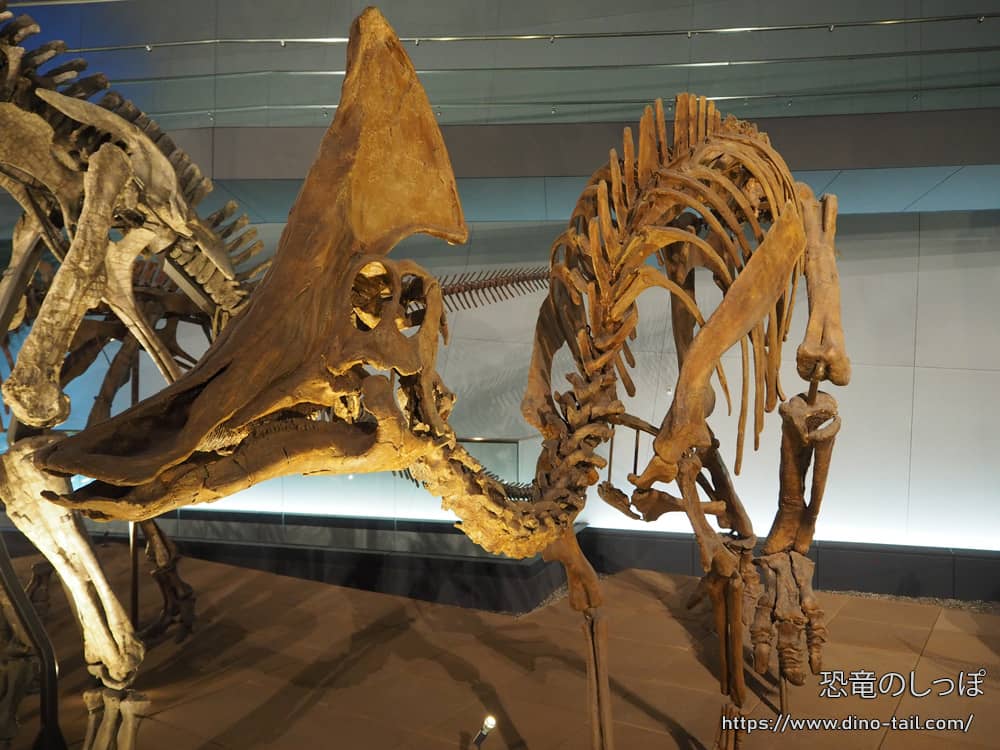
From the Ornithischia Ornithopoda, there was a complete skeleton of "Olorotitan." It was my first time seeing it. It is a hadrosaurid dinosaur discovered in Russia. It has more cervical vertebrae (neck bones) than other hadrosaurids, and its neck is long like a swan's, which is why its scientific name means "giant swan."
A specimen you should definitely see is the "Brachylophosaurus" displayed in the back. It is a hadrosaurid dinosaur belonging to the Saurolophinae subfamily, and many fossils have been found. The displayed specimen is a real mummified fossil with scales, beak, and claws preserved, nicknamed "Leonardo," and is one of the best-preserved fossils in the world. It is on loan for a limited time from the Great Plains Dinosaur Museum in Montana, USA, and is scheduled to be on display at the Fukui Prefectural Dinosaur Museum until 2033. See it soon!
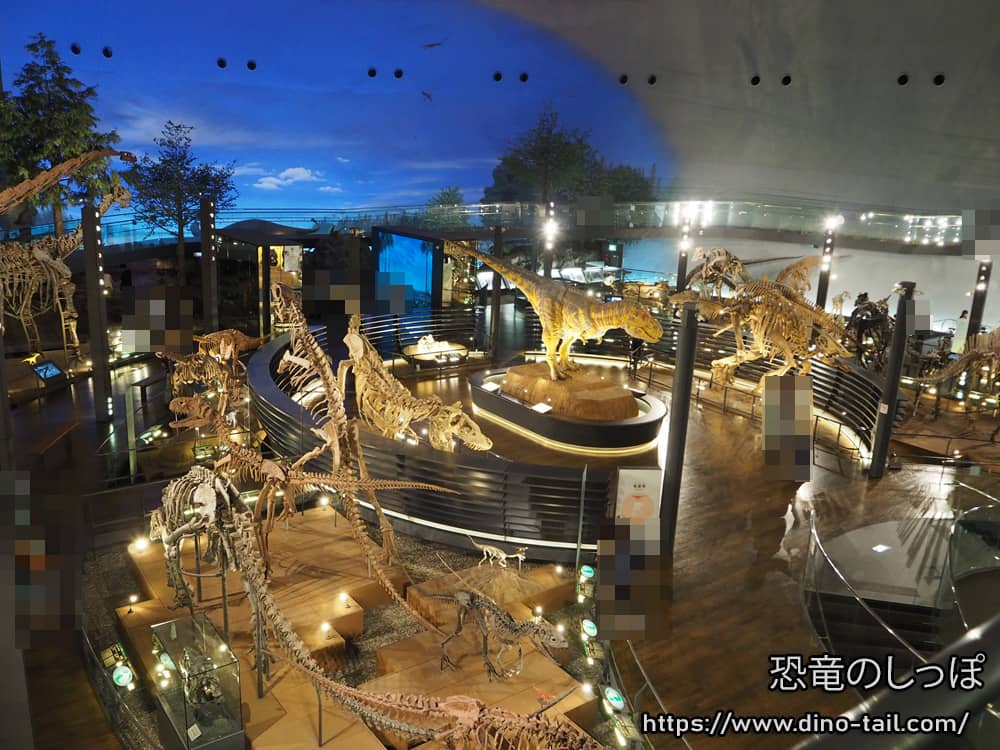
A ramp from the "World of Dinosaurs" area on the 1st floor leads to the "Dinosaurs of Fukui" exhibition area.
A complete skeleton fossil of a crocodile (Early Cretaceous) discovered in Katsuyama City, Fukui in 1982 was also on display. The discovery of this crocodile fossil led to a preliminary survey of the strata, where a carnivorous dinosaur tooth was excavated, prompting full-scale investigations in Katsuyama City, Fukui. Without this crocodile, the "Fukui Prefectural Dinosaur Museum" might not exist today.
In this area, Fukuiraptor, Fukuisaurus, Fukuititan, Fukuivenator, Koshisaurus, and Tyrannomimus are displayed.
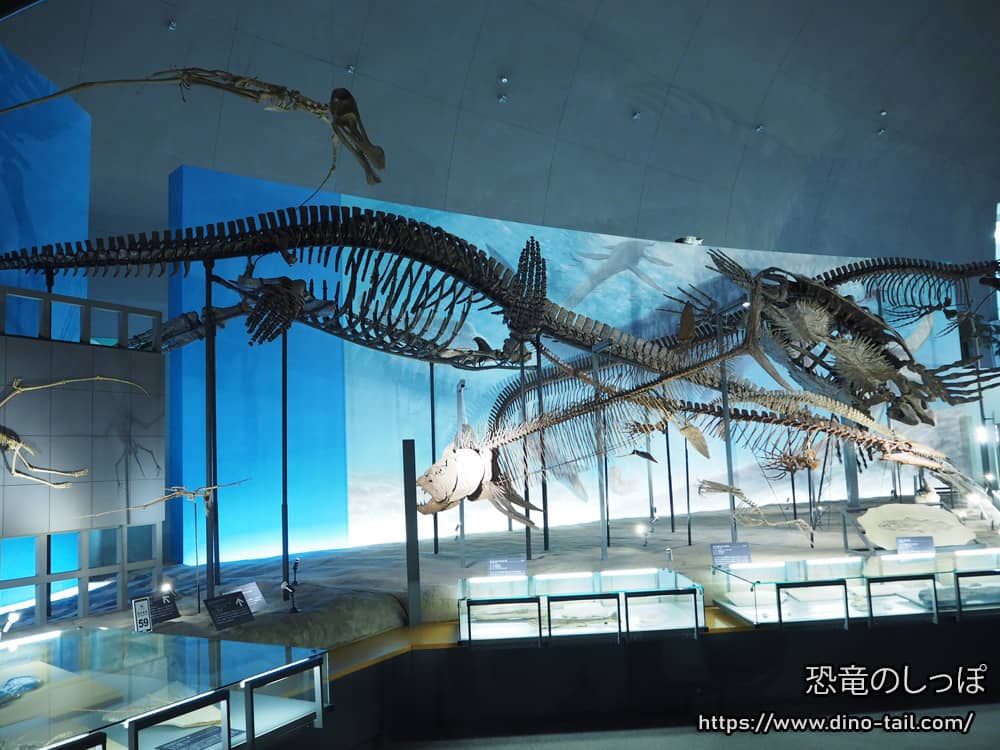
Pterosaurs, plesiosaurs, etc.
The "History of Life" area spreads out on the 2nd floor. This zone introduces the 4.6 billion-year history of life.
It continues from the Precambrian Dickinsonia and Kimberella (Ediacaran biota) to the evolution of vertebrates, fish, the move to land, amphibians, reptiles, the path to dinosaurs, feathered dinosaurs to birds, reptiles returning to the sea, pterosaurs, and the evolution of mammals.
In this area, familiar faces to paleontology fans such as Tylosaurus (Mosasauridae), Pteranodon (pterosaur), Sinosauropteryx (theropod), Archaeopteryx (theropod), and Archelon (sea turtle superfamily) were on display.
Day 1: Fossil Research Experience
Since it was almost time for the "Fossil Research Experience" I had booked (14:00), I moved to the new wing. You can have three experiences in the Fossil Research Experience space, newly established in 2023. The duration was said to be 120 minutes.
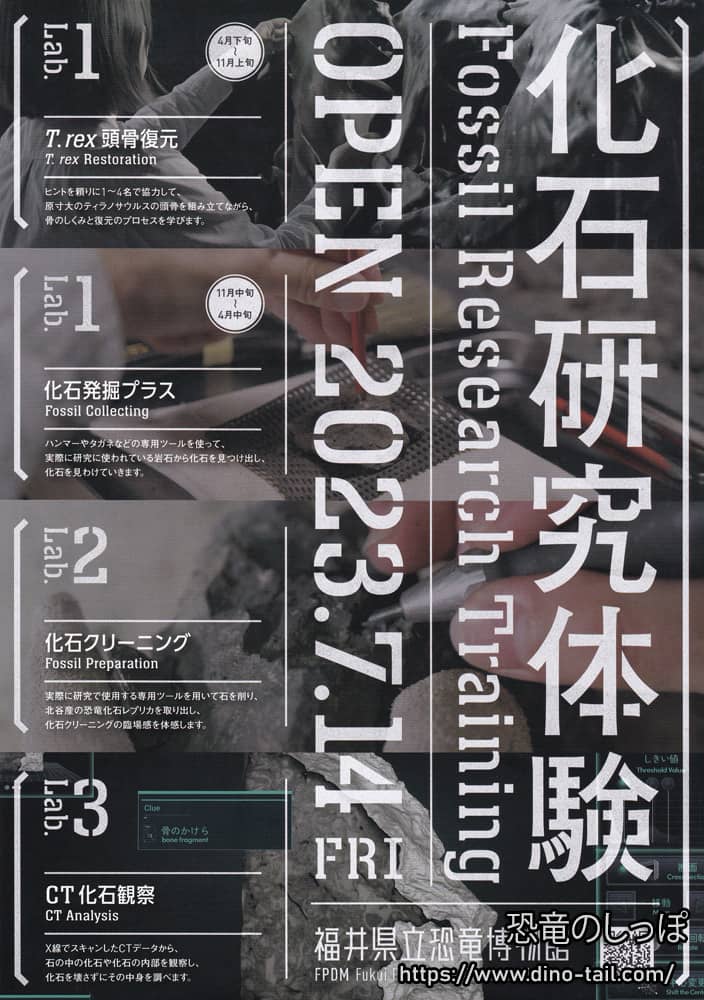
Lab.1 T.rex Skull Reconstruction
In teams of 1-4 people, this course involves assembling a large, life-sized replica of a Tyrannosaurus skull to learn about its structure. On the day I participated, our team had 3 people. Although it's a replica, it was created under the supervision of researchers, and we could observe the T.rex's braincase, eye sockets, jaw, and teeth up close.
The content of Lab.1 changes with the season. From early April to early November, it's the "T.rex Skull Reconstruction" I experienced, but from mid-November to mid-April, it becomes the "Fossil Excavation Plus" experience course.
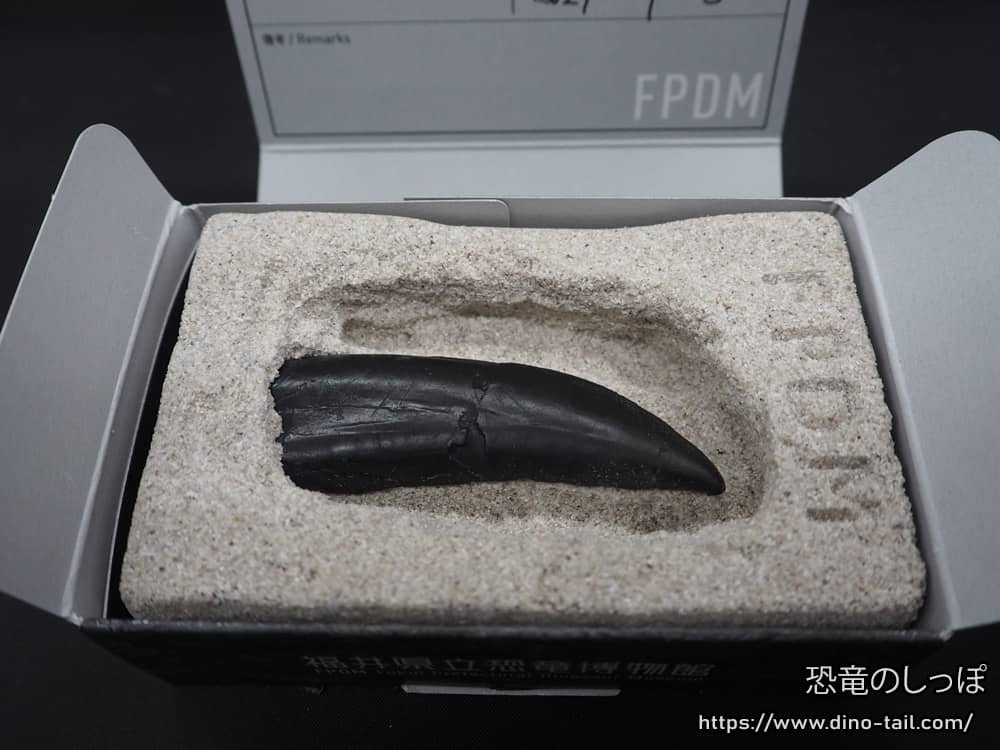
Lab.2 Fossil Cleaning
You get to experience extracting a fossil by chipping away at a rock with an air scribe, a tool used in actual fossil cleaning. Using a magnifying glass, you carefully extract a replica of a theropod tooth fossil, being careful not to chip too much. The vibration of the air scribe in my hand was exciting.
You can take home the extracted replica tooth in a provided box.
Lab.3 CT Fossil Observation
You can observe the interior of fossils from all 360-degree angles using X-ray scans. There are 12 types of fossils available for observation, including mammal skulls, rocks from the Kitadani Formation, and dinosaur fossils. Being able to see a cross-section of the fossil's interior with a touch panel was a valuable experience. The time flew by.
In March 2025, the "Fossil Research Experience" at the Fukui Prefectural Dinosaur Museum won an internationally prestigious design award in Germany.
It received the highest award at the "iF Design Award," a world-renowned German design award with a 70-year history. This time, there were over 10,000 entries from 66 countries, and the "Fossil Research Experience" won the Gold Award in the exhibition category of the interior architecture field. The black-themed space was praised as an experience facility that appeals to all age groups.
Day 2: Permanent Exhibition (Dino Lab)
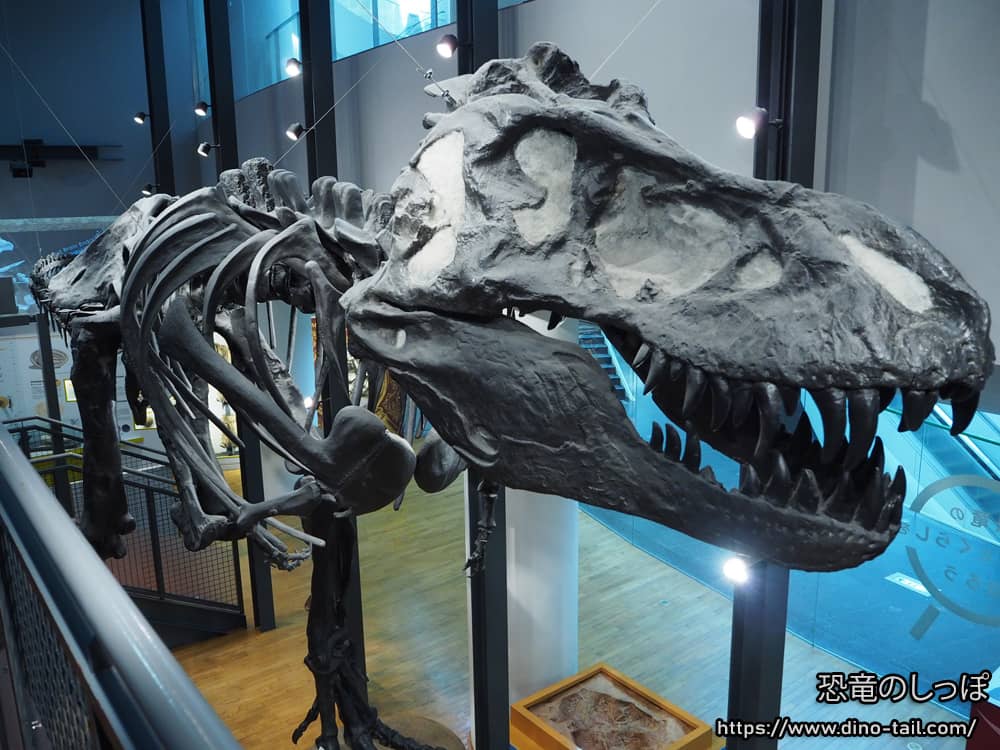
Between the 1st and 2nd floors of the main building, there was an area called the Dino Lab. It is marked by a massive, impressive Tyrannosaurus complete skeleton.
In this area, you can observe the complete skeleton fossil of a Tyrannosaurus up close from various angles. There are also exhibits where you can learn about the bodies and mechanisms of dinosaurs by observing things like the crest of a Parasaurolophus, the dental battery of an Edmontosaurus, and the growth lines in the femur of a sauropod.
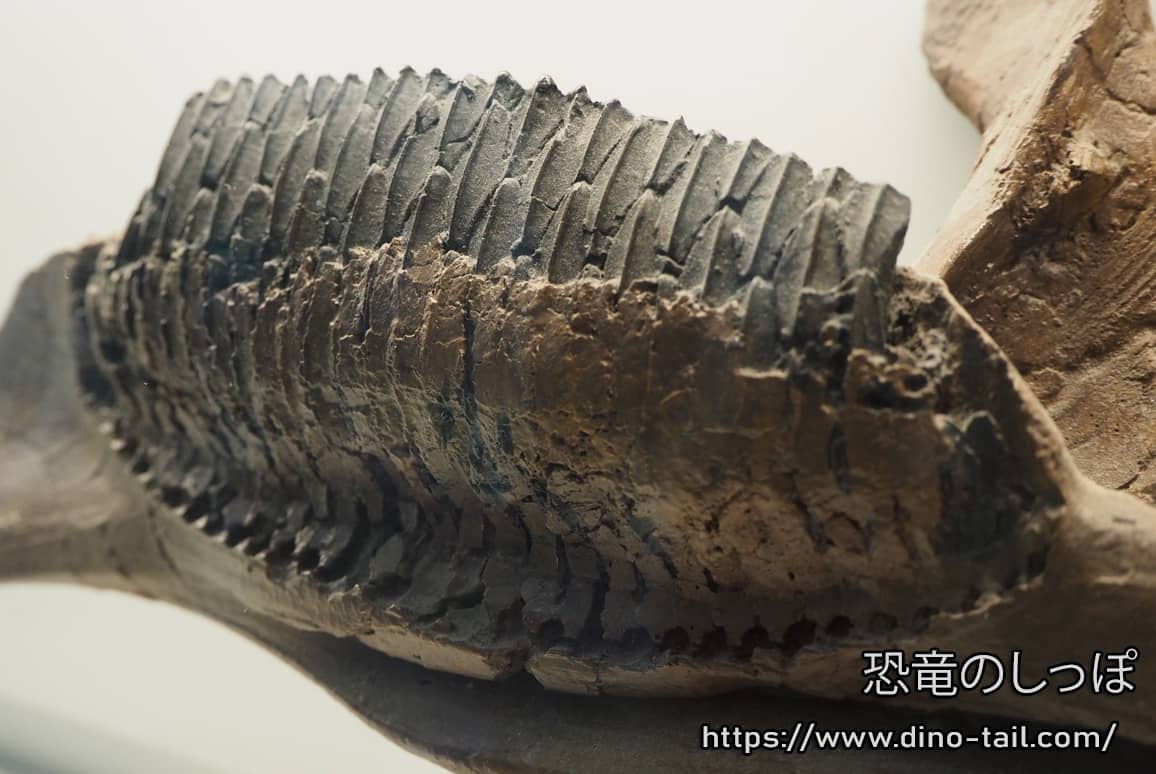
Day 2: Outdoor Dinosaur Museum
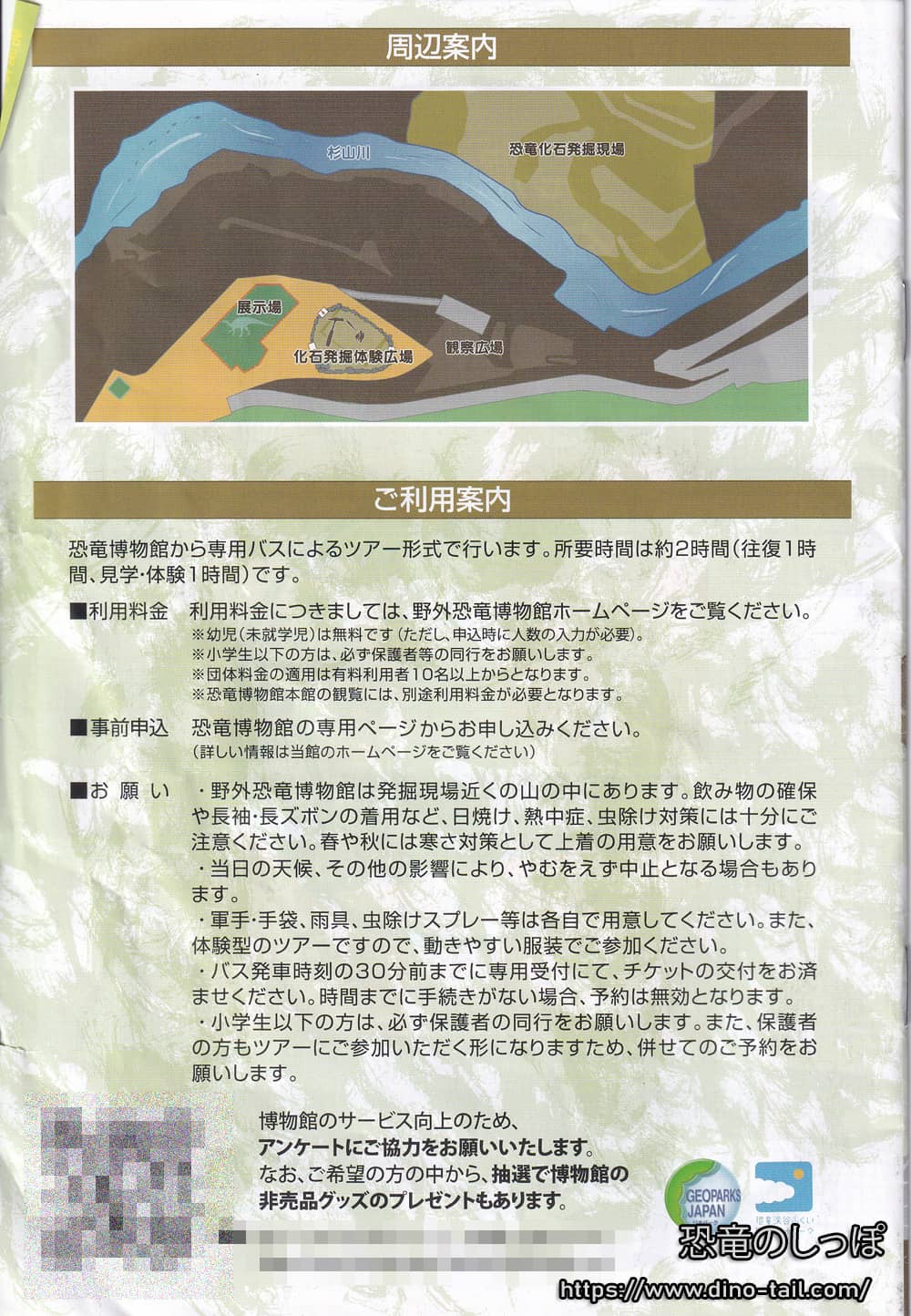
I participated in the Outdoor Dinosaur Museum tour departing at 11:10. I checked in at the museum's general reception 30 minutes before. This is a tour (limited to the snow-free season from April to November; the start date varies each year, so check the official website) that takes you by bus from the Fukui Prefectural Dinosaur Museum (main building) deep into the mountains to visit the dinosaur excavation site at the Kitadani Formation of the Tetori Group (about 120 million years ago) and experience fossil excavation. The tour lasts about 120 minutes. You need to bring gloves for the fossil excavation experience (hammers and goggles are provided). There were three buses available—Fukuiraptor, Fukuisaurus, and Fukuititan—but for my tour, two buses were running (with about 20 people on each). I was on the Fukuiraptor bus. I was impressed that there were quite a few participants for a weekday.
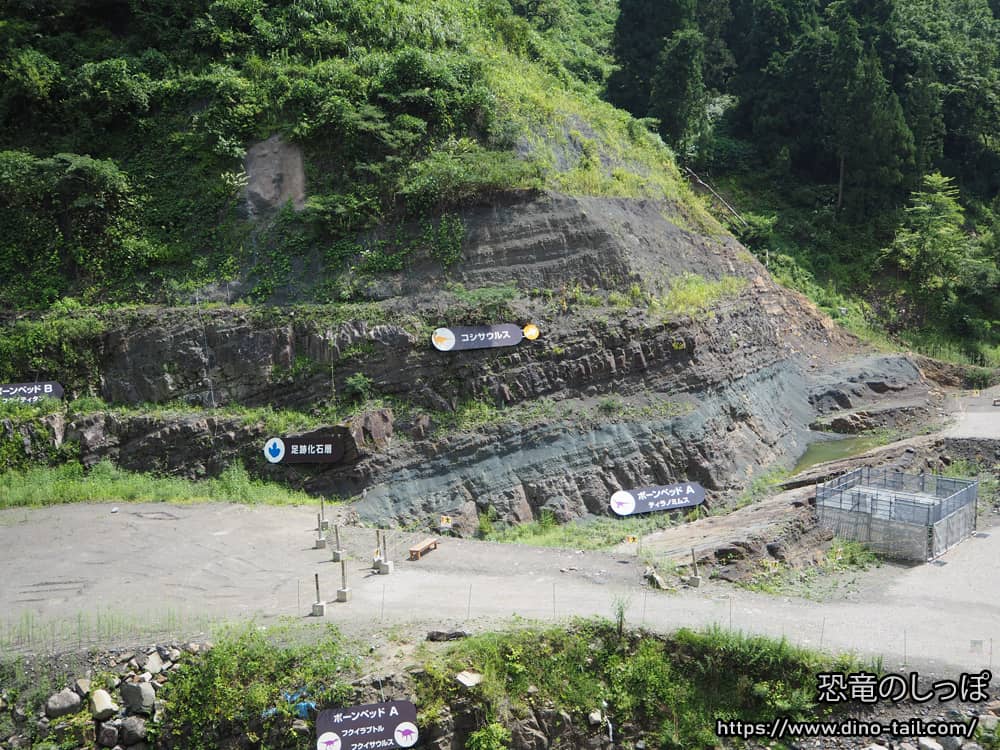
After about a 20-minute drive up a narrow mountain road, we arrived at the Outdoor Dinosaur Museum. Group 1, on the Fukuiraptor bus, started with the "Fossil Excavation Experience." We searched for fossils by breaking rocks brought from the Kitadani Formation, which spread out before us, under a tent. Many curators and curator trainees were there to support and encourage us in our fossil hunt.
I repeated the process of "picking up a rock, observing it closely, and trying to break it." They recommended that whitish sandstone is hard to break, while blackish rocks are easier to break and more likely to contain fossils. I found a plant fossil (plant and shell fossils are commonly found).
After the fossil excavation experience, we went to see the strata of the Kitadani Formation. I observed the strata, using panels indicating the discovery sites of "Fukuiraptor," "Koshisaurus," etc., as landmarks. I was amazed that "so many dinosaurs have been found in such a small area."
I was told that "2024 is a year when excavation surveys are temporarily suspended." If you visit the Outdoor Dinosaur Museum when a survey is being conducted, you can get a panoramic view of the actual excavation work.
After that, we toured the exhibition hall. We could hear explanations about the Kitadani Formation site where many fossils were found, the tools used for excavation, and dinosaur footprint fossils. Fossils of shells and plants were also on display, and it was a nice break inside the exhibition hall after the continued outdoor activities in the intense heat.
Day 3: Special Exhibition
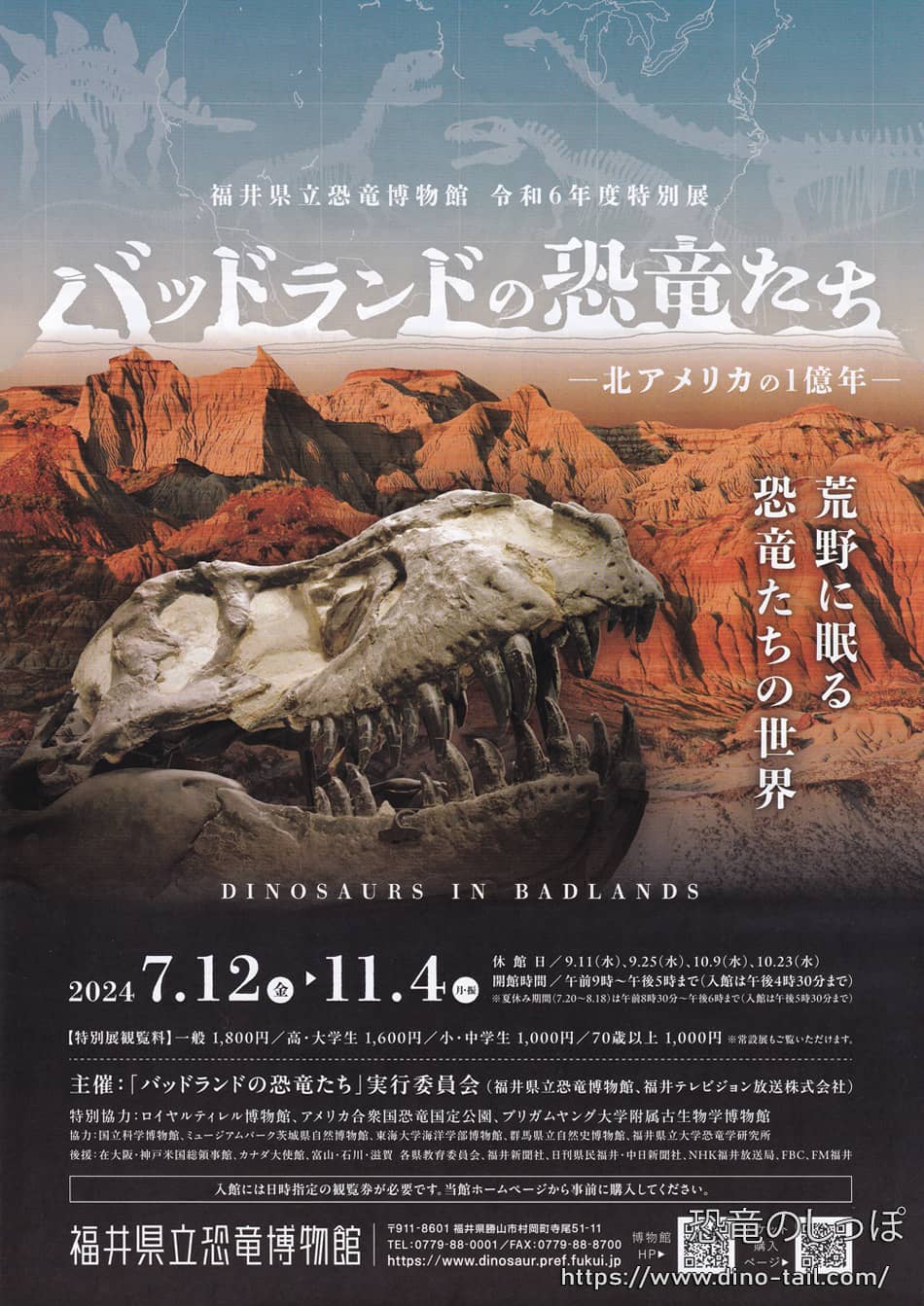
During my visit, the Fukui Prefectural Dinosaur Museum was holding the special exhibition "Dinosaurs of the Badlands."
The strata exposed in the wilderness known as the Badlands of North America contain fossils from the Late Triassic to the Cretaceous. This special exhibition traces the history of dinosaur research in North America, focusing on dinosaurs excavated from the Rock Point Formation of the Triassic, the Morrison Formation of the Jurassic, and the Cloverly, Cedar Mountain, and Dinosaur Park Formations of the Cretaceous.
I thought the highlights of the special exhibition were the "comparison between Allosaurus fragilis and Allosaurus jimmadseni" and the "real fossil skull of the Tyrannosaurus nicknamed 'Black Beauty'."
Personally, I was also happy to see the real skeleton of Maiasaura.
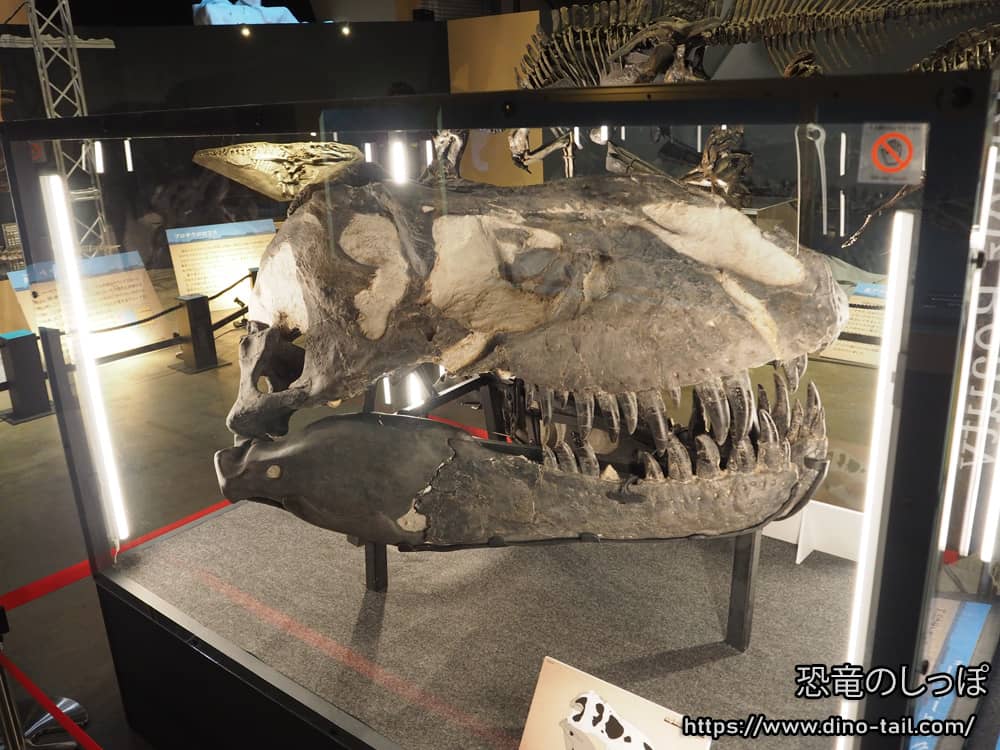
Reflections on the Visit
For a dinosaur lover like me, three days was the perfect length of stay. The permanent exhibition alone has enough volume to take up 1.5 days, and to cover the "Fossil Research Experience," "Outdoor Dinosaur Museum Tour," and "Special Exhibition," I thought, "I'm glad I planned for 3 days (5 days and 4 nights including travel)."
There were unexpectedly many tourists from overseas and families with small children.
Also, although COVID-19 has been downgraded to a Class 5 infectious disease, hand sanitizer was placed here and there throughout the museum, which was a small but reassuring touch.
Fukui Prefectural Dinosaur Museum
| Opening Hours |
9:00 AM to 5:00 PM (last admission at 4:30 PM)
*Summer extended hours may apply |
| Closing Days |
2nd and 4th Wednesday of the month (if a holiday, the next day; open daily during summer vacation)
Year-end and New Year holidays (December 31 and January 1) Other temporary closures for exhibition changes or facility maintenance may occur |
| Location | 51-11 Terao, Muroko-cho, Katsuyama City, Fukui 911-8601, within Katsuyama Dinosaur Forest |
| TEL | 0779-88-0001 (main) |
| Parking | Free (approx. 1,200 cars) |
| Official Website | https://www.dinosaur.pref.fukui.jp/en/ |
Side Story - Soft Serve Ice Cream
I found a delicious soft serve ice cream shop in Katsuyama City, Fukui.
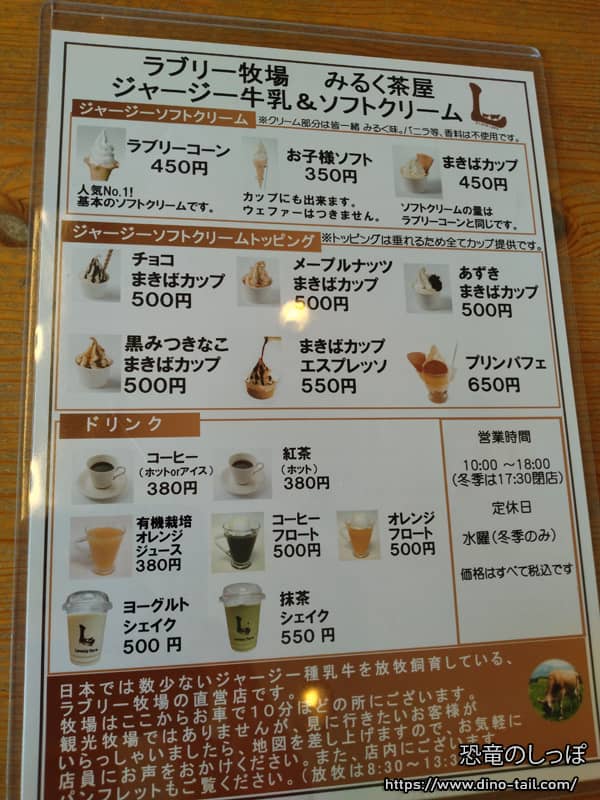
It's a direct-managed store of Lovely Farm in the Oku-Echizen Highlands of Fukui Prefecture, which raises Jersey cattle on mountain pastures. I went on the 3rd and 4th days of my trip and had a total of three soft serve ice creams. It's a rich milk-flavored soft serve. There are 12 seats inside the store.
The breakdown of the three I ate over two days was two Lovely Cones and one Maple Nut Makiba Cup. I recommend the Lovely Cone (450 yen, as of September 2024). If you're interested, please give it a try.
Milk Chaya Main Store
| Opening Hours | 10:00 AM to 6:00 PM |
| Closing Days | None |
| Location | 85-26-1 Hiraizumi, Hiraizumi-cho, Katsuyama City, Fukui, within the free parking lot of the museum |
| TEL | 0779-88-5691 |
| Parking | Katsuyama Castle Museum free parking |
| Lovely Farm Official Website | https://lovelyfarm.lovepop.jp/ |
